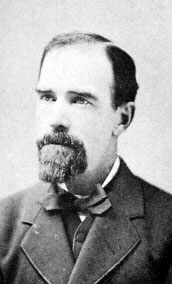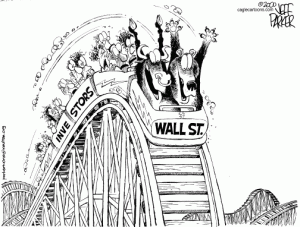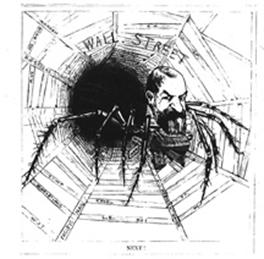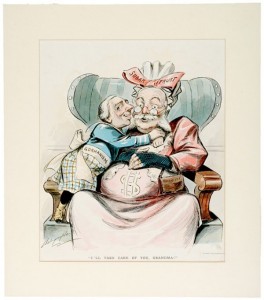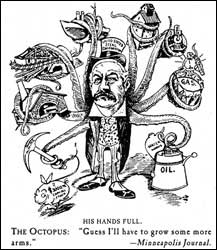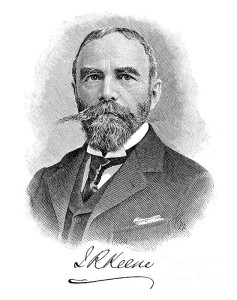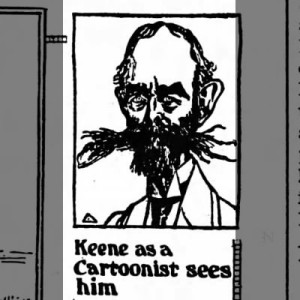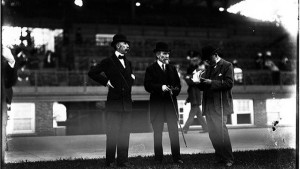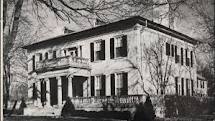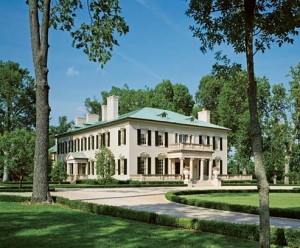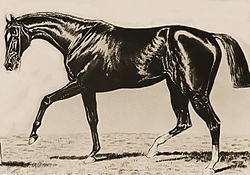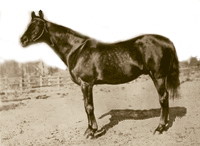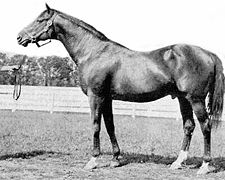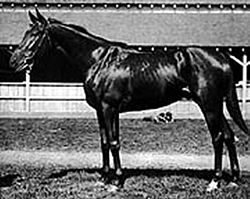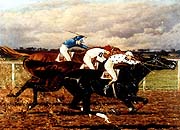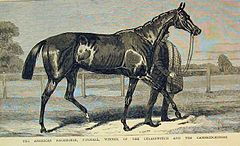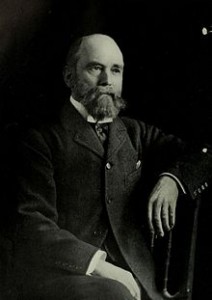James Robert Keene (1838 -1913) was the father of Foxhall Parker Keene, and therefore the father-in-law of Mary Lawrence, my wife’s great grand aunt. James Keene married the Virginian Sara Jay Daingerfield (1840 -1916). She produced two children, Jessica , who married Talbot Taylor, and Foxhall Parker.
James Keene was born in England in the family of a prosperous merchant who had gone bust, and his education was therefore cut short. When James was a teenager the family moved came to Shasta, California, to repair their fortunes.
James edited a newspaper, peddled milk, anything for a dollar. He went to work at Fort Reading as a minder of mules and cows; he made enough money in there months to buy a miner’s outfit and took off for the gold and silver mines. There he made enough money to come back to California to marry Sarah Daingerfield, the daughter of Colonel Leroy Daingerfield of Virginia and sister of Federal William Parker Judge Daingerfeld of California. The couple lived splendidly until James speculated and went broke. Senator Fenton gave Keene his seat on the San Francisco Stock Exchange and said Keene could pay when he could. Keene was appointed president of the San Francisco Stock Exchange and a governor of the Bank of California. He made $6,000,000 in the bonanza mines in the Comstock Lode in Nevada.
The Great Manipulator
In 1876, he traveled east on the way to Europe for his health. But he was distracted from his journey by the allure of Wall Street.
Jay Gould as seen by small investors
His Wall Street bitter rival Jay Gould once quipped, “Keene arrived in New York by private railroad car, and [Gould] would send him home to California in a boxcar.” Gould and his friends set put to ruin Keene, and Keene lost his $6,000,000. At the same time his Newport hosue burned down.
Keene lost everything to fire and bankruptcy, including his favorite painting. Rosa Bonheur’s sheep. It is said that a visitor to Gould’s house noticed the painting a nd Gould gloated “there hangs the scalp of James R. Keene.”
One of Rosa Bonheur’s many sheep paintings
Keene had his ups and downs on Wall street. He made a fortune, he lost a fortune. In 1879-1880 Keene tried to corner the wheat market but failed and lost perhaps $3,000,000.
Keene handled the affairs of Havemeyer for the Sugar Trust and helped J. P Morgan’s friends in the battle over control of the Northern Pacific Railroad.
J. P. Morgan consolidated 200 small steel companies into United States Steel. He hired Keene to drive up the price on Wall Street at the stock offering in \\ 1901. Keene established his office in an independent broker, Talbot J. Taylor (his son-in-law), to hide the Morgan connection and proceeded to buy US Steel heavily. Smaller investors thought Keene must know something, and poured money into the stock. Keene got the stock up to 55; by 1904 it was 8¾. The small investors lost; Keene and Morgan won. All of this behavior is now highly illegal.
According to his son Foxhall, when his father’s fortunes were restored
his first thought was to settle up. He gave a dinner party – it was a very large dinner – to all his creditors. Every man found on his plate, as a sort of place card, a cheque for the full amount owed him.
The Philosophy of Speculation
Keene was asked why he continued speculating even after he had made s much money and the speculation endangered him every time ”Why do you cling to the stock gambling game.”
His reply:
Why does a dog purse its thousandth rabbit?
You dog will chase its thousandth and even millionth h rabbit just as through it were the first he had ever seen” he’ll strive and start in pursuit of it to the point of heartbreak. One might suppose his soul’s life depended in its capture. And yet should he overtake it he will ast it aside when killed and will begin quartering the ground to start another. To the last gasp of his breath that dog will chase his rabbit. When you tell me why that dog wants another rabbit, I will tell you why I want more money.”
All his Wall Street comrades and competitors considered James Keene
a sportsman, who found in manipulating stocks and bonds the same excitement that other sportsmen might get from the roulette wheel or a big poker game.
Keene claimed that speculation was socially useful
All life is a speculation. The spirit of speculation is born with man. Providence had impressed on his head and brain the betting instinct. It is one of the greatest gifts with which he have been endowed.. Without speculation, call it gambling if you wish, initiative would cease, business would decay, values decline and the country go back twenty years in less than one.
The Turf
James Keene center, Foxhall Keene on left
Castleton Farms
John Breckenridge a future U.S. Senator and the Attorney General under Thomas Jefferson, bought 2,500 acres near Lexington, Kentucky to raise thoroughbred horses. His daughter, who had married David Castleman, inherited the farm and gave it the new name. She built the Greek Revival house.
James Keene bought it in the 1890s and added a 1,000 acres (it wasn’t big enough). Castleon became the source of some of finest race horses ever known: 113 stake winners were foaled there. Foxhall Keene, who had lived on the estate while undergoing his divorce from Mary Lawrence, inherited it. In 1913, he sold it to David Look, a fellow financier, who had difficulties in the Depression. In 1945 Frances Dodge Johnson bought it; after her death her husband Frederick Van Lennep held it, and the van Lennep Trust in 2001 sold it to Tony Ryan, the founder of Ryan Air. Ryan restored the house and renamed the farm Castleton Lyon, after his estate in Ireland.
Castleton Lyon
James Keene’s horses
Keene started buying racehorses in 1879, beginning with Spendthrift.
Spendthrift
Kingston
Kingston (1884-1912) won 89 races, the most in the history of the sport of thoroughbred racing.
Colin
Colin (1905=1932) was consistently rated as one of the best horses in American racing history, and was a celebrity with both fans and horsemen, Colin started fifteen times in his two-year career and never lost.
Sysonby
Sysonby (1902-1906) won every start easily, except one, at distances from one mile to two and a quarter miles. His superiority as a two and three-year-old was unchallenged during his short career of 15 race starts. Sysonby kicked off his 3-year old campaign in a dead heat for first with older horse Race King in the Metropolitan Handicap. It would be the last race where Sysonby was even challenged. He won the Great Republic and then won the Tidal Stakes, Lawrence Realization, Iroquois, Brighton Derby, and Century Stakes. Undefeated in nine races, he triumphed at distances from a mile to 2 1/4 miles. Sysonby was named 1905 Horse of the Year, as well as champion 3-year-old male, and earned $184,438 in his 15-race career.
Domino
Domino (1891-1897) was one of the first handful of horses inducted into the Nationa Musuen=m of Racing and Hall of Fame in 1955. His owner had his headstone engraved: “Here lies the fleetest runner the American turf has ever known, and the gamest and most generous of horses.”
Foxhall
Foxhall (1878-1904) , names after James’s son, As a three-year-old in 1881 he proved himself to be the outstanding colt of the season in Europe, winning the Grand Prix de Paris and becoming the second of only three horses to complete the Autumn Double of the Cesarewitch and the Cambridgeshire.
In 1907 Keene won more than $397,000 ($10,000,000 in 2015 dollars), which at that time was the greatest amount ever won in racing. From 1905 to 1910, Keene made over $1,200,000 ($30,000,000 in 2015 dollars) from the horses on his farm.
In 1908, London Sportsman Magazine declared that Keene possessed “the greatest lot of racehorses ever owned by one man.”
James Keene died on January 3, 1913, leaving an estate of $15,000,000 ($400,000,000 in 2015 dollars).
